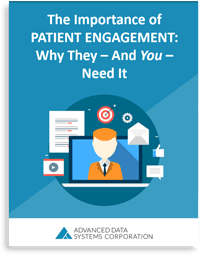Healthcare Blog
The latest in all things RCM, Electronic Health Records, Radiology Information Systems, Practice Management, Medical Billing, Value-Based Care, & Healthcare IT.

By:
Stephen O'Connor
September 23rd, 2013
A radiology information system (RIS) has the capacity to change the way a radiologist’s office conducts business and helps patients. Not every radiologic professional is convinced that computerized RIS systems are an improvement – mostly due to privacy concerns – but when properly implemented, these systems can save money, increase efficiency, catch more errors than paper systems, and improve patient outcomes.

Electronic Health Records | Industry News | Value-Based Care
By:
Advanced Data Systems Corporation
September 20th, 2013
The following is an excerpt from the ebook, "The Complete Guide to Electronic Health Records Software". The ebook covers a variety of information pertaining to EHR software, including vendor stability, common mistakes made during implementation, and how meaningful use can help your practice.

The Importance of Patient Engagement: Why They - And You - Need It
Learn why patient engagement is a necessity and how you can master it within your practice.

By:
Stephen O'Connor
September 16th, 2013
It’s not always easy to make a big change in how you run your medical facility, but putting off the implementation of practice management software can put your organization at a big disadvantage.

By:
Stephen O'Connor
September 13th, 2013
In the early years after you first opened your medical office, your organization may have been able to get by just fine using a paper-based system to keep everything running smoothly.

By:
Stephen O'Connor
September 11th, 2013
If you run a behavioral health practice, you have a wide range of vital information that you need to enter and work with on a regular basis as you process and treat each patient.

By:
Stephen O'Connor
September 9th, 2013
The clients who are sitting in your waiting room know that they can’t expect to see their doctor at the exact time of their appointment, given the unpredictable nature of how we practice medicine today. However, they will be happier if they know that your organization is doing everything possible to move things along more speedily and efficiently. This is where practice management software can make a big difference.

Electronic Health Records | Industry News
By:
Advanced Data Systems Corporation
August 28th, 2013
The following is an excerpt from the ebook, "The Complete Guide to Electronic Health Records Software". The ebook covers a variety of information pertaining to EHR software, including vendor stability, common mistakes made during implementation, and how meaningful use can help your practice.

By:
Stephen O'Connor
August 23rd, 2013
As manager or owner of a thriving medical practice who is looking for ways to boost staff efficiency and process more patients more quickly, you likely are preparing to begin using electronic health records (EHR) software in your organization. With so many competing EHR software vendors, you will want to know what to look for before making your purchase.

By:
Stephen O'Connor
August 21st, 2013
When making the transition from a paper records-based medical practice to a practice that uses electronic health records, one of the biggest challenges is how to get all that written information into the new digital records. No one wants to take on the task of having to retype all the patient information, and this would be a poor use of human resources, to say the least.

By:
Stephen O'Connor
August 7th, 2013
If your organization has been relying on generic or outdated electronic health record software to help keep things running smoothly at your practice, you are probably doing your staff and patients a disservice.